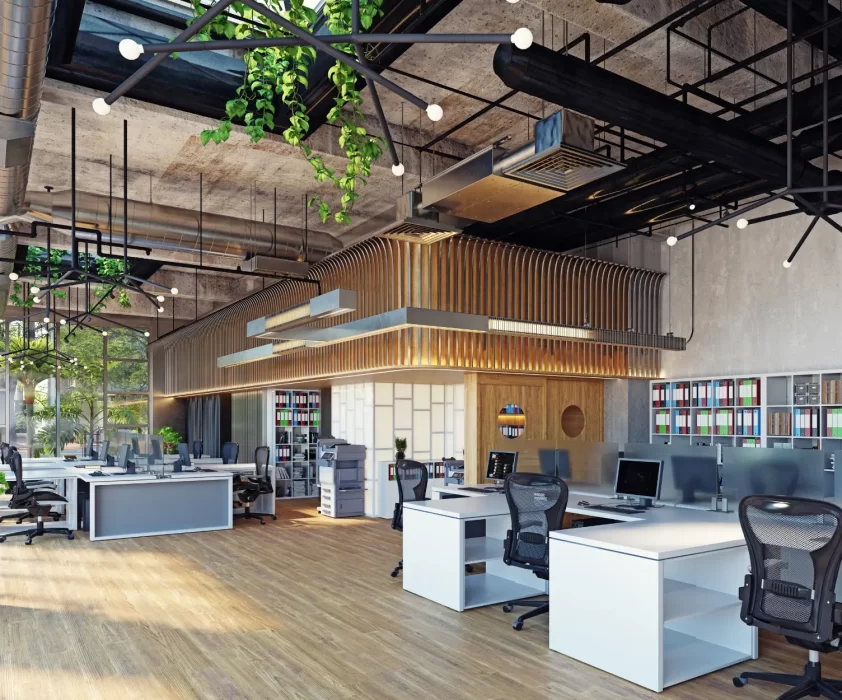
By David Kollar, Vice President of Workplace Strategy, Phoenix
The workplace is constantly evolving. Every industry, from farming to finance, changes over time with technology, process, and planning. Changes to the office since the 70’s include increased technology and collaboration, replacing cubicle farms with open floorplans, the disappearance of the landline and fax machine. But what’s coming next will be much more dramatic.
How and where we work is a hot topic, and it should be—we spend 1/3 of our lives working. Maximizing work time in terms of environment and productivity should be top of mind for occupiers.
The topic of where we work reached a boiling point with the 2020 pandemic stay-at-home orders. While some leaders hated the idea of their employees working from home, others who already incorporated some scheduled flexibility (or were considering it), embraced the chance to test the remote model. Whatever the stance, the outcome was the same—many of us were suddenly working from home.
CNBC reported how large corporations differ in their approach and messaging about returning to the office. Some like Bloomberg want to recreate the pre-pandemic setting—all workers in the office, every working day. Others such as The New York Times, Google, Apple, and Uber are all offering workers more flexible hybrid options. Media messages about if, when and how we will return to the office remain mixed. But as many of us do slowly return to the office, full-time or as part of a hybrid model, much has changed. To encourage workers back to the office and attract and retain talent, better workspaces can give organizations a competitive advantage. The same is true for landlords and investors, attracting and retaining tenants will be easier when the space offered combines quality, convenience, productivity, and flexibility.
Evolving Trends
An office that is creatively planned and efficiently designed in terms of space, engagement, and productivity simply creates a more enjoyable place to spend time. Workplace trends already underway pre-Covid have been accelerated by the pandemic and look set to continue changing our work environment. Trends in design innovation workspace operations can be broken down into four major categories.
- Space Planning
- Employee Experience
- Technology
- Flight to Quality
Space Planning: Private offices are often no longer prioritized. A rise in demand to remove hierarchical structures and replace corner offices with open plan space helps to facilitate a sense of connectivity between co-workers, collaboration, and knowledge sharing. By incorporating a variety of space designs and flexibility for different activities we can promote collaboration, when desirable, and privacy, when necessary (me space vs. we space). For example, phone booths for private or confidential calls and huddle rooms for intentional collaboration, conferences, and meetings.
The secret to successful open-plan environments lies in understanding occupier needs. This could mean using sound masking to prevent excess noise transfer, planning for density, attractive design, and efficient layouts with options for both assigned seating and desk hoteling, where employees reserve desks before coming to the office to accommodate the flexible schedules and the hybrid work model. By monitoring space usage, cost savings can be identified such as resources, utilities, and reduced space allocation if needed.
Convenience, health, and wellbeing: As workers prioritize their health and wellness, demand is increasing for workplaces with safety measures such as Covid cleaning protocols, access to outdoor space, and amenities such as fitness studios, tenant lounges, and coffee shops. Employee satisfaction, and therefore tenant/employee retention and organizational resilience, can be achieved by providing convenient access to things that will make people’s lives easier or better.
Top Office Features Include:
- Blended offices: combining social, collaborative, and private space
- Biophilic design: focus on natural light and greenery
- Gym/fitness facilities with showers
- Coffee and lunch options on-site
- On-site services such as dry-cleaning pickup, childcare and dog sitting
- Tenant lounge with entertainment options
- Privacy pods, quiet zones and nap rooms
Technology: With remote and hybrid working impossible to ignore, progressive technology such as cloud computing, Microsoft Teams, resource scheduling applications such as Envoy for desk registrations, virtual reality software, and speedy file transfer software, will certainly ease the transition between home and office. Providing secure systems will allow multi-tasking, collaboration, and engagement wherever members of the team might be that day.
Not surprisingly, a recent survey report from 451 Research estimated 40% of organizations use workforce productivity and collaboration tools more because of the pandemic. Retaining talent and tenants depends on adapting and setting up the office infrastructure (both physical and tech) to satisfy new and changing demands for workplace flexibility.
Employee Experience: Employers are increasing their focus on what the day-to-day experience is like for their employees. The Great Resignation strongly suggests that a large number of employees did not feel appreciated at their previous job. One way for employers to express their gratitude is to provide a workplace that their employees can be proud of. Demand for Trophy and Class A office space is on the rise, and companies are prepared to pay the uplift for location, quality, and amenities. Consideration must be given to proper planning of the interior space for maximum employee engagement and productivity gains. We come back to design, layout, programming, change management, and technology.
The workplace is changing, and you need a strategy.
A Workplace Strategy.
Adapting to change is difficult. As many of us return to the office, the demand has increased for quality, planned, and curated workspaces. The approach to developing a workplace strategy must include a tailored and adapted process for each organization or investor’s space and requirements.
Strategies include:
- Growth forecasting
- Employee and management surveys
- Density and use studies
- Office efficiency – design and layout
- Spec suite creation
- Environmental wellness (lighting, ventilation, sound, access) to suit ESG framework
- Amenity opportunities
- Technology studies, pricing, and recommendations
By studying the market and the psychology of the workplace, the team identifies trends and changes that can reveal a better way and a more engaging place to work. By studying our environment and how we respond to it, we can create a space that workers want to return to, one that they would choose over the comfort and convenience of their homes. Doing so will lead to the following results.
- Organizations will engage and retain their talent. They will become more innovative, productive, and cost-effective.
- Individuals will benefit from increased engagement, productivity, and improved performance thanks to an organized, flexible, and enjoyable workplace.
- Landlords and Investors will benefit from updating their offering to keep pace (or outpace) the competition, to retain tenants, and maintain the value and appeal of their property.
2020 accelerated the need for innovation, it changed the way we work and pushed technology ever further forward. Through planning and design, by applying Workplace Strategies, business leaders and landlords alike could improve the day-to-day lives of their employees or tenants. Many of Stream’s clients sought our advice on how to navigate the challenges of planning throughout the pandemic and beyond. Responding to their needs and the ever-increasing demand, Stream established Workplace Strategies, a service to help investors and occupiers create and maximize workspaces for enjoyment and productivity.
As we continue to monitor the data and apply this proven service for our clients, we ask you this: What’s your workplace strategy?
